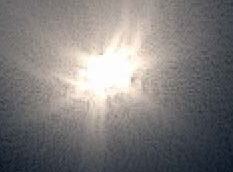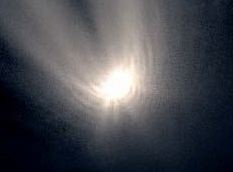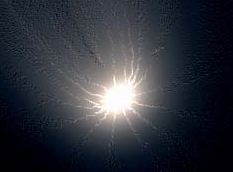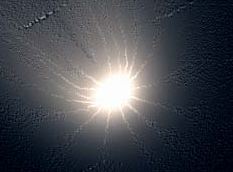
ONE MODEL OF
DEVELOPMENT AND BEHAVIOR IN OUR SOLAR SYSTEM
Part Two: The Spring Mysteries
(Updated 4-26-97)
The breakthrough images on this page are from Ian Griffin at the Astronaut Memorial Planetarium and Observatory in Clearlake Florida.

As the comet continues to baffle and confound the astronomical community, there are still those few individuals that are able to come up with truly revealing and landmark findings. These images are indeed incredible revelations showing the comet's unexpected and erratic behavior.
The growing "tendrils" that emanate from the inner coma have developed over time (images are in order down the page). The inspired yet ignored and publicly ridiculed scientist Immanuel Velikovsky theorized that there would be a great discharge of energy as two bodies come within reach of each other's field. This strange occurrence began as the comet approached the 40 degree parallel of the sun and the ecliptic (approximately .9 AU's or about 87 million miles from the sun).
The "tendrils" reach out thousands of miles from the surface of Hale Bopp appearing like bolts of electrical energy. To date there has not been a credible explanation of this behavior from any of the previously mentioned astronomers. Unfortunately, Dr. Griffin had to discontinue his recording of these images due to his need for back surgery.
It is indeed unfortunate and some might say curious that the imaging stopped just as this behavior began to increase. We wish Dr. Griffin a speedy and full recovery!

Another finding that has "puzzled" scientists, not only in Hale Bopp but in 1996's great comet Hyakutake, is the detection of X-rays. Apparently Hale Bopp's power is greater in many ways than the status quo has expected.
Here is a quote of the ongoing study of these emissions:
"More X-rays from Hale-Bopp
M. J. Mumma and V. A. Krasnopolsky (Goddard Space Flight Center, NASA) and their colleagues report (IAU Circular 6625 April 14) the detection of soft X-rays, He I (58.4 nm), and O II (53.8 nm) during 1996 Sept. 14-19 UT (r = 3.07 AU) with the EUVE orbiting observatory.... The central brightness was displaced from the nucleus by 140 000 +/- 60 000 km in the sky plane.
A region of extended x-ray emission is also seen, and this is anticorrelated with the dust jets imaged simultaneously in the visible. The observation of line emission is very interesting and will undoubtedly help to elucidate the mechanisms responsible for the X-ray emission from comets. The low abundance of Neon is puzzling."

And another interesting tidbit:
"University of Cincinnati astronomer Michael Sitko and his collaborators have found similarities between the composition of Comet Hale-Bopp and what appear to be similar-sized comets in other solar systems.
'They're almost identical,' said Sitko. 'We compared the spectrum of our star with the spectrum of Hale-Bopp. It looks as if the material we see in these stars is exactly equal to the material that's being seen in Comet Hale-Bopp.'
Sitko reported his findings during the recent International Conference on the Formation and Evolution of Solids in Space March 10-21 in Erice, Sicily. They're based on infrared observations of evolving solar systems where a new star is surrounded by a great disc of dusty material.
His evidence will be published in the formal proceedings from that meeting. So far, the researchers have identified 15 such systems using earlier ultraviolet spectra obtained with the International Ultraviolet Explorer (IUE) satellite, a forerunner of the Hubble Space Telescope.
Although no one has searched the systems for direct evidence of planets, Sitko says there is circumstantial evidence that planets have formed. For example, the team found several star-grazing comets which are rushing at tremendous speed (up to 400 kilometers/second) toward a collision with the central star.
'As far as anybody knows, the only way to make an object like a comet hit a star is to have some source of gravity to throw it down there,' said Sitko.
'In our own solar system, it's things like Jupiter and Saturn. So, we think there's a good chance these systems will have planets circling them.'
Because the researchers have seen so many star-grazing comets, it appears the systems are in a heavy bombardment period, similar to the bombardment period which left the great craters on the surface of Earth's moon over four billion years ago. The researchers hope to make additional observations this fall, but they'd also like to conduct what Sitko calls the 'reverse experiment.'
They want to look for similar patterns in systems where astronomers agree planets have been found. If the same combinations of minerals and elements are seen, that would indicate that solar systems tend to follow the same pattern of evolution. If the patterns don't hold up, that would indicate there is more than one way to build a solar system."
It's amazing that these "comets" hold together at such high speeds. It is also curious that they are able to see comets when planets have been so difficult to acquire in other systems! Is this an indication of how big Hale Bopp really is?

Another suspicion that I had entertained over the past several months, was whether or not the shuttles and the MIR space station, have been imaging the "comet of the century" all along?
I had known that on one mission the astronauts had a high tech infrared telescope, but there were never any images of the comet ever released! Surely the view of this magnificent object from space must be breathtaking. Then the shuttle had to make a quick break, back to the earth due to what was reported as a fuel cell problem.
This was only days prior to the biggest Solar Coronal Mass Ejection ever reported was to strike the Earth. My suspicions were recently confirmed when several images taken from that flight were posted on the internet. The images show the comet just following "their" sunset.
It makes one wonder as to why the Hubble Space Telescope cannot utilize the Earth to block the sun and get some pics of the comet too?

The other interesting discovery of these last few days has been the finding of the sodium tail. Here's the report of the discovery:
"Santa Cruz de La Palma, the 18th of April 1997.
- Observations carried out in the past few days to study the distribution of sodium atoms in Comet Hale-Bopp have led to the discovery of a new type of comet tail. Sodium atoms have previously been seen near the centers of other comets, but these observations reveal for the first time in Hale-Bopp a straight tail of sodium atoms 6 degrees long.
The discovery images were taken on the CoCAM wide-field CCD camera, built and operated by staff at the Isaac Newton Group on La Palma, set up next to the 2.5m Isaac Newton Telescope.
To their great surprise the astronomers found that these atoms are distributed over an enormous region in and around the comet. Contrary to earlier observations of bright comets near the sun, the sodium was present not only in the region next to the cometary nucleus, there were also large amounts in the region of the cometary tails.
Following a careful analysis of the observed distribution of these atoms, the astronomers concluded that Comet Hale-Bopp displays a third type of tail never seen before and consisting of sodium atoms.
Whereas the well-known ion and dust tails so prominently displayed by Hale-Bopp show a large amount of structure, the new sodium tail has a completely different appearance. It takes the form of an approximately 600,000 km wide and 50 million km long tail, in a direction close but slightly different to that of the ion tail.
While the electrically charged particles in the ion tail are accelerated to large velocities by the solar wind (very fast atomic particles emitted by the Sun), there is no obvious explanation at this moment of how the observed sodium tail is formed.
Nevertheless, the astronomers in the team believe that the sodium atoms may be released in-situ from very small dust grains or molecules. These particles or molecules are emitted by the cometary nucleus and then transported into the tail at high velocity by at present unknown mechanisms."
Sodium is not usually found as a solitary element in nature. It is very unstable and quickly bonds with other elements. It is interesting that Hale Bopp has been able to do this and that the sodium is being expelled at a different rate than the other volatiles.
This has never been seen with another comet!